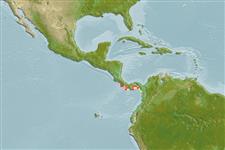>
Ophidiiformes (Cusk eels) >
Ophidiidae (Cusk-eels) > Ophidiinae
Etymology: Lepophidium: Latin, lepus, leporis = rabbit + Greek, ophis = serpent (Ref. 45335).
Environment: milieu / climate zone / depth range / distribution range
Écologie
marin démersal; profondeur 73 - 209 m (Ref. 91765). Tropical; 10°N - 4°N, 84°W - 77°W (Ref. 91765)
Distribution
Pays | Zones FAO | Écosystèmes | Occurrences | Point map | Introductions | Faunafri
Pacific Coast of northern Colombia to Costa Rica.
Taille / Poids / Âge
Maturity: Lm ? range ? - ? cm
Max length : 21.7 cm SL mâle / non sexé; (Ref. 91765)
Description synthétique
Clés d'identification | Morphologie | Morphométrie
Rayons mous dorsaux (Total) : 128 - 134; Rayons mous anaux: 108 - 113; Vertèbres: 71 - 73. This species have the following characteristics: pyloric caeca usually 4-8 in 2 whorls, typically 2-3 in first 2 whorls and 1in third; usually 3 rudimentary gill rakers on the upper arm of the first arch and 5-7 developed rakers on lower arm, 1-6 rudimentary rakers anteriorly on the lower arm; total gill rakers 9-14; dorsal-fin origin between neural spines 3-4; roof of mouth posterior to the palatine and vomerine tooth patches blackish, also the gill bars, upper pharyngeal region, esophagus, caeca, and anterior part of the intestine; pectoral fins dusky; dorsal and anal fins have a dark edge; males have the anterior rib thickened (Ref. 91765).
Life cycle and mating behavior
Maturities | Reproduction | Spawnings | Egg(s) | Fecundities | Larves
Robins, C.R., R.H. Robins and M.E. Brown, 2012. A revision of Lepophidium (Teleoastei, Ophidiidae), with descriptions of eight new species. Bulletin of the Florida Museum of Natural History 52(1):1-94. (Ref. 91765)
Statut dans la liste rouge de l'IUCN (Ref. 130435)
Menace pour l'homme
Harmless
Utilisations par l'homme
Outils
Articles particuliers
Télécharger en XML
Sources Internet
Estimates based on models
Phylogenetic diversity index (Ref.
82804): PD
50 = 0.5000 [Uniqueness, from 0.5 = low to 2.0 = high].
Bayesian length-weight: a=0.00102 (0.00046 - 0.00225), b=3.06 (2.88 - 3.24), in cm total length, based on all LWR estimates for this body shape (Ref.
93245).
Niveau trophique (Ref.
69278): 3.6 ±0.7 se; based on size and trophs of closest relatives
Résilience (Ref.
120179): Haut, temps minimum de doublement de population inférieur à 15 mois (Preliminary K or Fecundity.).
Fishing Vulnerability (Ref.
59153): Low vulnerability (16 of 100).
